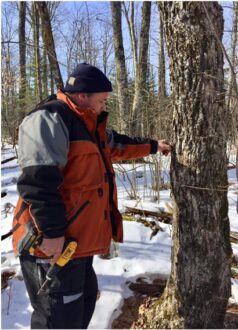In the melting snow of a northeastern Minnesota forest, you’ll find Eric Dupuis busily tapping maple trees. As a sugarmaker, Dupuis works in a sugarbush, a stand of maple trees used for sugarmaking. Dupuis has been a sugarmaker for more than 15 years with the Nagaajiwanaang band of the Anishinaabe Ojibwe people in Minnesota.
Making maple syrup and sugar is an ancient tradition of the Ojibwe people. Long before colonists arrived, the Ojibwe people set up sugarbush camps in late winter to make maple sugar and syrup. Some of these camps have been in the same families for generations (Native Harvest, 2022).
Dupuis’ grandfather had a small sugarbush that Dupuis would visit as a child, and Dupuis started sugarmaking with his dad many years ago. They began with 30 trees and expanded from there. Today, Dupuis runs the sugarbush with about 350 taps to collect sap from the trees (he uses 1-2 taps per tree). Sugarmakers must cook the sap steadily, constantly adding fuel to reduce sap into syrup. 40 gallons of sap yields one gallon of syrup, so the cooking time is significant. Dupuis fuels his sugarmaking equipment using wood he harvests from the surrounding forest. As the size of the sugarbush increased, so did the labor.
In 2019, Dupuis applied for and received a $9,000 NCR-SARE Farmer Rancher grant to make lasting improvements to their sugarbush. Working with the University of Minnesota Duluth’s Center of Economic Development, Dupuis created a business plan to sustain their sugarbush with improved efficiency and community engagement.
Improving efficiency meant increasing production and reducing fuel consumption. Dupuis documented that he could save time and wood by changing his system, including updating his evaporation pans, filter press, and other heating equipment. After implementing these adjustments, he improved his ratio of sap to syrup from ~20 gallons per cord of wood to ~30 gallons per cord. He was able to make more syrup with less wood. By reducing the amount of wood he needed, he also reduced labor.
“Having a more efficient evaporator means burning less wood, which means fewer pollutants released from that, and fewer trips running the ATV back and forth hauling wood,” explained Dupuis.
Community Sugarmaking
As part of the project, Dupuis involved more community members in sugarmaking. Working with Fond du Lac Tribal Community College’s Thirteen Moons extension program, he hosted sugarmaking workshops. Community members learned to identify maple trees during winter, practiced tapping trees, and helped install and maintain a tubing system. As they boiled sap together, they became more familiar with the process and one another.
“One family became involved with the sugarbush workshops from the beginning,” said Dupuis. “Most participants are single participants. However, this group was a family that included their 11-year-old daughter. Their participation was a great example of community participation.”
Dig Deeper
Dupuis shared his research at the Emerging Farmers Conference in Minnesota in 2021. A recording of the presentation is online at https://www.youtube.com/watch?v=HiGj42gYUA8.
NCR-SARE’s Farmer Rancher program starts accepting proposals in mid-August. Learn more here.
